

Essentially, Egyptian hieroglyphs represent consonants only. However, a few could be used to represent vowels in non-Egyptian words and names.
To write an English name in hieroglyphs, it is important to think about how the name is pronounced, not how it is spelled. For example, if your name is Phillip, you should start your name with the hieroglyph for F, not P and H* In fact, the Egyptians wrote the name Philipos with P and H, or simply P. In the 4th century BCE, the Greek letter Phi, the first letter of Philipos, was pronounced as an aspirated P. It changed to F much later. . Also, there is no need to double the L.
Silent letters should not be written. The 'e' in Jane is silent; it doesn't need to be written.
When a vowel occurred in a unstressed syllable, the Egyptians didn't think it necessary to write it, so you shouldn't either. Names such as Reuben and Allison can be written as RUBN and ALISN (or ALSN).
The following table shows the hieroglyphs which I recommend for writing English names.
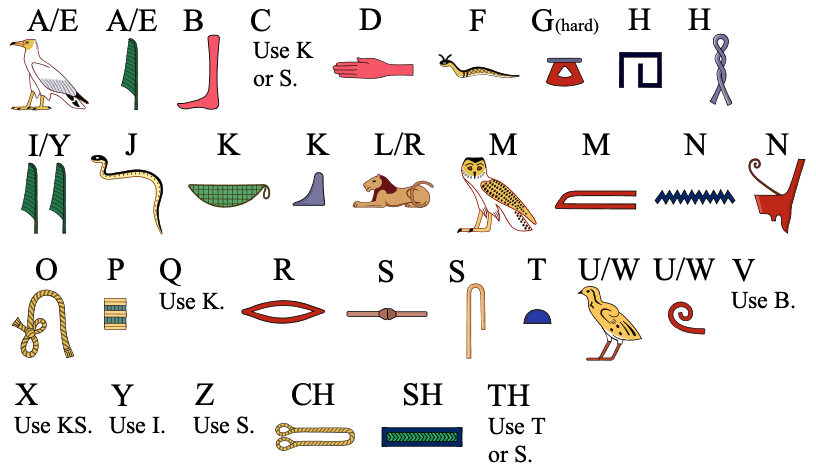

Let's look at an example. The name Sophie can be represented as SOFI.
The corresponding hieroglyphs are shown at right.
| The hieroglyphs can be arranged vertically or horizontally. Adjust the size to minimize empty space, as shown here. |  |
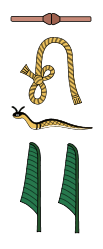 |
| Egyptians wrote royal names inside a loop of rope, called a cartouche. Draw a cartouche around your name and adjust the size. | 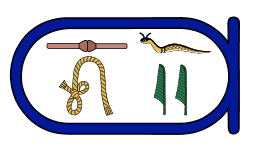 |
 |
The table below has details about the hieroglyphs used to write foreign names.
The Trans. column gives the symbol used by Egyptologists to transliterate the hieroglyph. IPA symbols, when given, are between slash marks: //.
| Trans. | Comments | |
|---|---|---|
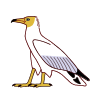 |
ꜣ |
An Egyptian vulture. Originally this may have represented an 'r' sound (/ʀ/), and later, a glottal stop (/ʔ/). During the Ptolemaic period, it could be used to represent a vowel, 'ah' or 'eh', in Greek names. |
 |
j |
A reed leaf. Originally, this may have been a voiced palatal approximant, which is a fancy way of saying 'the consonant y'. By the Middle Kingdom it had become a glottal stop /ʔ/. In Ptolemaic times, it was used to represent a vowel, 'ah' or 'eh'. |
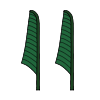 |
y |
Two reed leaves, representing the consonant 'y', or the vowel 'ee' /i/. |
 |
ꜥ |
A forearm. This represents a voiced pharyngeal fricative /ʕ/. For speakers of Arabic, this is the consonant ayin (ع). To European ears, ayin sounds like 'ah'. |
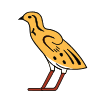 |
w |
A quail chick. This represents the consonant 'w'. It was also used to represent the vowel sound 'oo' /u/. |
 |
w |
Although it looks like a coiled rope, this hieroglyph is an abbreviation for the quail chick, borrowed from hieratic. It also represents 'w' or 'oo' /u/. |
 |
wꜣ |
A lasso. In Ptolemaic times, used to represent the vowel 'oh'. |
 |
b |
A foot. Pronounce as 'b'. It can also be used to represent 'v'. |
 |
p |
A stool. Pronounce as 'p'. |
 |
f |
This animal may look like a slug, but it's actually a snake with horns near the eyes, a horned viper. Pronounce as 'f'. |
 |
m |
An owl. Pronounce as 'm'. |
 |
m |
Unknown object. Originally it represented the consonants /jm/, but during the New Kingdom, it started to be used for /m/. |
 |
n |
Water. Pronounce as 'n'. |
 |
n |
The crown of Lower Egypt. During the 18th Dynasy, this hieroglyph started to be used as an alternative to the water hieroglyph above. Pronounce as 'n'. |
 |
r |
A mouth. This represents an 'r' sound, possibly flapped, as in Spanish. |
 |
h |
A reed shelter? Pronounce as an English 'h'. |
 |
ḥ |
A lamp wick made of twisted flax. This is an 'h' sound, but stronger than the previous. It is the same as the Hebrew Ḥet (ח) and the Arabic ḥāʾ (ح). |
 |
ḫ |
A placenta? This hieroglyph represents a voiceless uvular fricative: /χ/. Pronounce as the Modern Greek letter chi (χ). |
 |
s |
A folded cloth, at the back of a chair. Pronounce as 's'. |
 |
z |
A door bolt. During the Old Kingdom, the sound of this consonant was distinct from 's', but by the time of the Middle Kingdom, it had merged with 's'. |
 |
š |
A pool of water. Pronounce as 'sh'. |
 |
k |
A basket with a handle. Pronounce as 'k'. |
 |
q/ḳ |
The slope of a hill. This hieroglyph represents a voiceless uvular stop /q/. /q/ is quite similar to 'k', but the sound is made further back in the throat. |
 |
g |
A jar stand. Originally, this hieroglyph was pronounced as 'g'. During the Late Egyptian period, the 'g' sound merged with 'k'. For this reason, this hieroglyph is used to write the name of the Ptolemaic queen Berenike. |
 |
rw |
A lion, used to represent 'r' or 'l' in the names of Ptolemaic royalty. |
 |
t |
A loaf of bread. Pronounce as 't'. In Egyptian, nouns of the feminine gender originally ended with 't'. Final t's became silent in the spoken language, but they were still written. Egyptians wrote Cleopatra with a silent final 't' (Kleopatrat) to indicate that the name was feminine. |
 |
ṯ |
A tether. Pronounce as 'ch' in 'chart'. |
 |
d |
A hand. Originally pronounced as 'd'. In Late Egyptian, this sound became merged with 't'. |
 |
ḏ |
A cobra. Pronounce as 'j' in 'just'. |